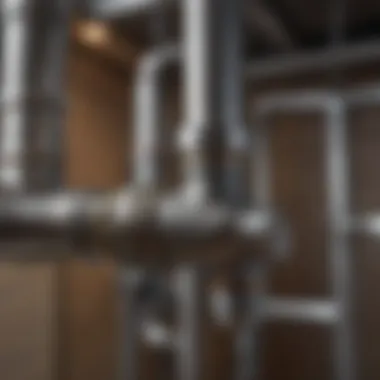New House Walkthrough Checklist: Comprehensive Guide


Intro
Purchasing a new house is a significant milestone in one's life. It represents not just a financial investment, but also a space for memories, growth, and comfort. However, before signing that final paperwork, it is crucial to conduct a thorough inspection to ensure that the property aligns with expectations. This checklist serves as a practical guide, helping potential homeowners assess various critical aspects that affect their future living experience.
Understanding what to look for—from structural integrity to operational systems—can provide deeper insights into the property's condition. This knowledge not only aids in informed decision-making but can also prevent future hassles post-purchase.
In the following sections, we will break down essential elements to consider during the walkthrough. By examining these closely, future homeowners can ensure that they are making a well-informed commitment to their new home.
Prelims to the New House Walkthrough
The process of purchasing a new house can be both exciting and overwhelming. Conducting a thorough walkthrough is a critical step that separates a successful purchase from costly regret. This walkthrough serves as an essential framework for assessing the condition and suitability of a potential new home.
A home walkthrough checklist is designed with specific purposes in mind. It aids homebuyers in systematically reviewing various elements of the property, which may range from structural issues to system functionality. This ensures nothing goes unnoticed, creating a clearer picture of what to expect from the new residence.
Purpose of the Walkthrough Checklist
The primary purpose of the walkthrough checklist is to guarantee a comprehensive evaluation of the home. The checklist acts as a reference tool, guiding buyers through the inspection process. This ensures all necessary aspects receive attention, reducing the risk of overlooking critical details. Key features often included on a checklist may contain:
- Structural Integrity: Evaluating the foundation and walls for any signs of damage.
- System Functionality: Checking plumbing, electrical, and HVAC systems.
- Aesthetic and Compliance: Ensuring that the interior and exterior of the house meet personal tastes and adhere to local regulations.
By utilizing this checklist, homebuyers can make informed decisions. It also assists in negotiating better terms by making buyers aware of potential issues that could arise post-purchase.
Importance of Diligence in Home Buying
Diligence during the home buying process cannot be overstated. Many factors come into play, and overlooking even minor details can lead to significant consequences. Homebuyers should approach each step with caution and thoroughness.
A diligent inspection may uncover issues ranging from simple cosmetic flaws to severe structural problems. Ignoring these could lead to incurring additional costs in repairs and renovations after the purchase. An attuned eye can help identify:
- Water Damage: Often unnoticed during casual viewing can signal larger issues either within the roofing or plumbing.
- Code Compliance: An unsatisfactory inspection can reveal violations of local building codes, which might require rectification post-purchase.
- Long-term Investment Concerns: Examining potential problem areas ensures that buyers are aware of future maintenance needs and expenses.
Pre-Walkthrough Preparations
Pre-walkthrough preparations are a vital part of the home-buying process. This phase sets the foundation for a successful and thorough inspection of a potential new home. Well-planned preparation can mitigate many risks and prevent future headaches. It allows buyers to approach the walkthrough with a clear mindset, armed with important knowledge about the property, its history, and their own requirements.
One of the main benefits is that preparing ahead of time can help buyers identify potential red flags before they become even bigger issues. This proactive approach reduces the likelihood of missing crucial details that could impact their purchase decision. After all, buying a house is one of the largest investments a person will make in their lifetime.
The following subsections delve into specific preparation areas that will empower buyers to conduct a more effective walkthrough.
Structural Inspection Areas
The structural inspection areas are critical during a new house walkthrough. These sections involve assessing elements that are essential for the safety and longevity of the home. Not only do they ensure the home meets building codes, but they also enhance your understanding of potential issues that might lead to costly repairs later on. Focusing on these structural components can significantly affect the overall decision-making in the home buying process.
Roof Condition
Signs of Damage
In roofing, signs of damage denote issues like cracks, leaks, or warping. Recognizing these signs is vital as they can indicate larger problems, such as water infiltration or structural weakness. A key characteristic of these signs is how they can vary in visibility; sometimes they are subtle and might require closer inspection.
The presence of noticeable damage can affect property value, influencing negotiation areas post-walkthrough. For buyers, understanding the implications of roof damage is beneficial. It can also lead to necessary repairs that ensure longevity and safety.
However, lack of visible signs does not mean the roofing is perfect; routine checks are advisable. Regular assessments help to avoid more severe issues down the line.
Material Quality
Material quality is another significant aspect of the roof assessment. The type of materials used, such as asphalt shingles, metal, or tile, can have a long-lasting impact. High-quality materials tend to require less upkeep, which can save homeowners money over time.
The durability of material is a key characteristic. For example, metal roofs can last longer than their asphalt counterparts. The unique feature of using quality materials is their performance in harsh weather conditions, thus extending overall longevity. However, they can incur higher upfront costs.


Foundation Integrity
Cracks and Settling
Examining cracks and settling reveals important information about a house’s foundation stability. The key characteristics of visible cracks or settling can be a sign of shifting soil or inadequate foundation design. Recognizing these signs is vital because they can point to significant structural concerns that, if untreated, lead to more extensive damage.
This evaluation is popular among real estate enthusiasts due to its direct impact on property value. Cracks can range from mere cosmetic issues to substantial threats to integrity. Therefore, when observed, potential buyers must assess the severity.
Drainage Systems
The assessment of drainage systems is crucial for ensuring that water is being effectively redirected away from the home. Proper drainage plays a pivotal role in preventing water damage to the foundation and lower levels. A good drainage setup helps maintain structural integrity and minimizes moisture problems in the basement.
This characteristic of preventing water buildup is essential for maintaining a dry environment. Unique to drainage systems is the consideration of soil type and landscape slope, which can affect performance. Poor drainage may cause high costs for repairs and remediation in the future.
Wall Structure
Drywall Stains
Drywall stains often indicate moisture problems or leaks within the walls. Their presence is an important red flag that should not be overlooked. Moisture can lead to mold growth, which can be hazardous for health. The key characteristic of these stains is their color and spread, which can provide clues about the severity and source of the issue. Addressing them quickly can be beneficial to avoid potential health risks and costly fixes.
The unique aspect of drywall stains is that they sometimes require professional assessment to identify the source, potentially delaying necessary repairs or influencing house price discussions.
Insulation Quality
Assessing insulation quality is essential for energy efficiency in a home. Poor insulation can lead to higher energy bills and uncomfortable living conditions. An important characteristic is the material used, whether it is fiberglass or foam, affecting performance and energy conservation.
The unique feature of quality insulation is its ability to regulate temperature levels, making a significant difference in energy costs over time. However, improper installation can lead to ineffective insulation, requiring additional assessments or replacement.
Understanding these structural inspection areas can empower potential homeowners to make informed decisions, ensuring they choose a property that aligns with their needs and values. By paying attention to these details, buyers can avoid future headaches and financial burdens.
Key Systems Evaluation
Evaluating key systems is crucial during a new house walkthrough. This phase assesses the functional aspects of essential home systems. Not only can significant repairs be costly, but they can also impact your comfort level within the home. Therefore, checking these systems provides more than reassurance; it gives insight into future maintenance needs.
Plumbing System Check
A plumbing system check involves examining both water flow and visible integrity. It is foundational for ensuring that all water-related features in the home operate correctly.
Water Pressure Assessment
The water pressure assessment is vital for determining whether the home’s plumbing can support daily needs effectively. Low pressure may indicate leaks or problems with the water supply. A key characteristic of this assessment is the measurement of flow rate, often indicated in gallons per minute (GPM). It is beneficial as it directly affects daily activities, like showering or washing dishes.
A unique feature of this assessment includes testing faucet outputs throughout the house. Ensuring consistency across all fixtures is essential for identifying specific issues in localized areas. If pressure is found to be inadequate, it may lead to further scrutiny of the plumbing system, which could involve additional costs in repairs.
Visible Leaks
Visible leaks are another critical aspect. Identifying leaks can prevent extensive damage to both the property and your finances. A key characteristic of leak detection involves visually inspecting areas under sinks, along walls, and near water appliances. This is advantageous as it can reveal issues before they escalate.
One unique aspect of visible leaks is that they can originate from various sources, such as old pipes or damaged fixtures. The advantage here is that addressing them early can save significant repair costs down the line. However, if leaks are concealed behind walls or under floors, uncovering them may require professional help, which could be more complex and costly.
Electrical System Review
The electrical system review checks wiring and safety features in a home. This step plays an essential role in ensuring that the property is safe for habitation.
Circuit Breaker Functionality
Circuit breaker functionality must be evaluated to ensure safe electrical distribution. Functioning circuit breakers can prevent power overloads, adding safety to the home. A key characteristic lies in testing the tripping mechanisms of the breakers, which is essential for assessing their operational status.


The assessment is popular because effective circuit breakers can signal potential electrical issues before they result in hazards. A distinctive feature of this review involves testing all breakers for proper function. If any seem unresponsive, it could indicate an underlying issue with the home’s wiring, necessitating immediate attention, especially if upgrades are needed.
Outlet Safety
Outlet safety is another important evaluation. Homeowners should check for the presence of ground fault circuit interrupters (GFCI) outlets in wet areas. A crucial characteristic of this inspection is ensuring outlets are not overloaded and that visible wiring is intact.
The benefit of this check is that it prevents electrical shock hazards and fire risks. Unique features to consider include inspecting for corrosion or burn marks. If any issues are observed, they warrant immediate action to prevent potential accidents, representing a necessary investment in home safety.
Heating and Cooling Systems
Proper functioning of heating and cooling systems is essential for maintaining a comfortable living environment. Assessing these systems during a walkthrough informs buyers of the potential for expensive repairs.
HVAC Performance
The HVAC performance check evaluates the overall effectiveness of heating and cooling units. Key characteristics include examining the age and condition of the furnace and air conditioning unit. Regular functionality tests also play a role in this assessment.
This step is crucial as it directly affects home comfort throughout the seasons. Additionally, understanding the system's energy efficiency rating can inform potential costs. Any shortcomings noted can lead to necessary replacements, impacting your budget significantly.
Thermostat Functionality
Thermostat functionality must not be overlooked. This assessment ensures that the temperature regulation system operates properly. A significant characteristic involves checking whether the thermostat accurately reflects room temperature and adjusts accordingly.
This feature is essential because an ineffective thermostat can lead to inconsistent home temperatures and higher energy bills. If the functionality shows issues, they can be relatively easy to fix, although buying a new thermostat may be preferable in some cases. Understanding its limitations can help anticipate future needs for upgrades or replacements.
Evaluating key systems is an essential part of the walkthrough checklist. Without thorough checks, the risks associated with costly repairs or safety concerns significantly increase after the purchase.
Interior and Exterior Observations
The interior and exterior observations are critical in the house walkthrough checklist. These assessments help identify not only the aesthetics of a property but also its functionality and potential issues. Assessing both interior and exterior areas informs potential buyers about maintenance needs and overall livability. It can save future expenses on repairs and renovations.
Kitchen Condition
The kitchen holds a significant place in any home, often seen as the heart of the family space. Therefore, its condition is vital.
Appliance Functionality
Appliance functionality includes assessing all major appliances such as ovens, dishwashers, and refrigerators. A well-functioning appliance is essential for daily use and convenience. Buyers should ensure that appliances operate correctly. It's a vital aspect because malfunctioning appliances can lead to unexpected costs.
Also, energy-efficient appliances are popular choices among homeowners. They not only save on energy bills but are often better for the environment. However, these appliances might also demand a higher upfront cost.
Cabinet Integrity
Cabinet integrity is another crucial element of the kitchen assessment. Buyers should check for any signs of wear, water damage, or poor installation. Well-maintained cabinets are important for long-term use. They offer ample storage and can enhance the overall appearance of the kitchen.
A unique feature of cabinets is the material used; choices range from solid wood to laminate. Solid wood cabinets often offer durability and a classic look, while laminate provides affordability. Each choice has distinct advantages and disadvantages related to cost and longevity.
Bathroom Functioning
Bathrooms are essential for comfort and hygiene, so their functioning should not be overlooked.
Shower and Tub Inspection
Shower and tub inspections comprise checking for leaks, water pressure, and overall cleanliness. Functioning showers and tubs greatly affect living quality. A well-maintained shower system is essential for daily routines.
In many modern homes, a unique feature is the presence of dual showerheads or rainfall capabilities; these add a luxury element. However, they can require more maintenance than traditional fixtures, especially if water quality is poor.
Sink and Toilet Functionality
Assessing sink and toilet functionality is necessary during the walkthrough. This involves checking for blockages, leaks, and proper flush mechanisms. A functional sink and toilet are foundational for everyday living. The characteristic of low-flow toilets has gained popularity due to water-saving benefits. While they help save on water bills, they may have less power in flushing, which can be a disadvantage in some situations.
Living Spaces and Layout
The evaluation of living spaces and layout plays a major role in how comfortably a buyer can live in the home.


Room Dimensions
Room dimensions dictate how functional a space is. Buyers should consider not just the size but also how the dimensions fit their lifestyle. Spacious rooms allow for flexibility in furniture arrangements, which is highly beneficial. Unique features like open floor plans offer a modern aesthetic. However, this might compromise privacy for some residents, depending on their preferences.
Flow and Accessibility
Flow and accessibility should be assessed to determine how well spaces connect with one another. Good flow encourages natural movement within the home, vital for comfortable living. Thoughtful layouts promote accessibility, particularly for those with mobility issues.
A unique part of good flow is the idea of open versus closed spaces. Open layouts create communal living experiences but might lack the coziness of more defined, enclosed areas. Buyers should weigh these characteristics according to their lifestyle needs.
Outdoor Amenities and Concerns
Evaluating the outdoor space of a new house is just as vital as inspecting its interior. Outdoor amenities and concerns can significantly impact the overall livability, aesthetic appeal, and even the value of the property. A well-conceived outdoor area extends usable living space and enhances personal enjoyment. Elements such as landscaping, parking facilities, and boundary definitions contribute to both functionality and security. Failing to pay attention to these outdoor factors can lead to oversights that impact your investment.
Landscaping and Drainage
The state of the landscaping can resonate deeply with your experience in a new home. It’s essential not only for visual appeal but also plays a crucial role in drainage and soil health. Proper landscaping can prevent issues related to excess water accumulation that can lead to foundation problems or pest infestations.
Inspecting the yard for slopes and drainage patterns is wise. Check for downspouts that direct water away from the house and ensure that the land slopes away from the foundation. Overhanging trees may pose risks of falling branches. It's prudent to look for native plants that require less maintenance and provide benefits to the local ecosystem. Reviewing these elements will guide future decisions regarding maintenance and enhancements.
Garage and Parking
The availability and condition of parking spaces and garages can affect your daily routine and property value. A garage not only provides protection for vehicles but also offers storage space and a minor work area.
When evaluating a garage, consider its size and whether it fits your automotive needs. Assess if it has proper ventilation and adequate access to power sources. Inspect the garage door for functionality and security features. Additionally, examine parking availability outside the garage. Safe, convenient parking can greatly affect perspectives of the property.
Fencing and Boundaries
Boundaries define privacy, security, and property limits. Thus, inspecting the fencing is crucial. Are the fences in good condition? Should they be reinforced or replaced? Determine if they meet your needs for security and visual enjoyment. Look for any signs of decay or damage.
Also, check local ordinances regarding fence height and materials. Knowledge of your property lines protects against disputes with neighbors and aids in future landscaping plans. Clear boundaries not only contribute to aesthetics but also support an atmosphere of confidence in your ownership.
"Outdoor space is an extension of your living area, playing a major role in your overall satisfaction with a property."
Curating the outdoor area can reveal much about the livability and true value of a home while serving as a reflection of personal style and preferences. Make sure to critically assess these elements as part of your overall walkthrough checklist.
Final Considerations
When a buyer reaches the final stages of their new house walkthrough, it is crucial to approach this process not as mere formality, but with a strategic mindset. The final considerations are where buyers synthesize all observed elements and prepare to make informed decisions. This phase can have substantial implications on the negotiation, final purchase decision, and overall satisfaction with the home. Engaging with these considerations deeply is essential for maximizing value in the buying process.
Negotiation Areas Post-Walkthrough
After completing the walkthrough, buyers often find themselves in a position to negotiate. It is common to identify issues that may have been overlooked initially. Common negotiation areas can include but are not limited to:
- Structural damages found during inspection
- Outdated or defective systems, such as plumbing or electrical
- Necessary repairs deemed significant enough to warrant a price adjustment
A skillful approach to negotiation can lead to re-evaluating the offer on the table. It is critical to observe what issues need addressing and equate those to monetary value. Buyers should document these concerns with photographs and notes during the walkthrough, allowing them to present a solid argument on why the price should be re-assessed.
Deciding on Next Steps
Once the walkthrough and negotiations have concluded, the next steps illuminate the pathway ahead. Buyers must evaluate their options based on the findings. This could mean:
- Proceeding with the purchase at the negotiated price
- Requesting the seller to complete repairs before finalizing the sale
- Walking away from the deal if significant issues arise that alter their willingness to buy
Each scenario bears unique implications for the buyer's future. If agreeing to the purchase, setting up final paperwork and seeking financing aligns with agreed-upon terms. If the decision leans toward requesting repairs, clear communication with the seller about expectations is fundamental. If walking away, leveraging insights gained from this walkthrough can be valuable in future property searches.
Engaging Professional Inspectors
Sometimes, despite personal diligence, conditions of the house may warrant a closer inspection. It is prudent to consider hiring professional inspectors for their expertise. They have the training and experience to identify complications that may not be visible to the untrained eye. Key advantages include:
- Comprehensive assessment of the home’s condition
- Objective analysis, providing insight unrelated to personal sentiment
- Detailed reporting that can inform future maintenance or repairs
Professional inspections often cover areas that go beyond visual findings. From hidden mold in basements to electrical system assessments, these elements can prevent future headaches. Ultimately, a professional inspector not only serves as a safety net but as an essential component in assuring that the investment is worthwhile.
Conclusively, the final considerations in the new house walkthrough checklist lead to crucial decisions that ultimately shape the homeowner's experience and satisfaction. By navigating negotiations wisely, evaluating next steps thoughtfully, and fostering relationships with professional inspectors, buyers can secure a home that meets their needs and preferences.



